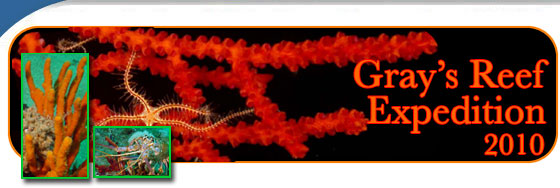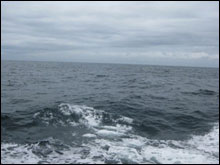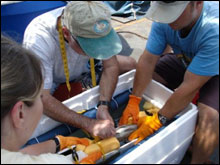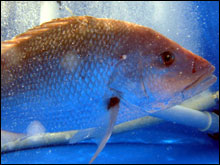 | ||||||||||||||
|
|
|
|
|

This is my third and last day aboard. As sanctuary communications coordinator, I've been escorting members of the media around the ship and facilitating their interviews with the scientists. The focus of this leg of the mission is the sanctuary's on-going fish tagging project. We want to learn about just how reef-dwelling groupers and red snappers use the habitat. What is learned from this project will inform how the sanctuary is managed for the future. Both species have undergone overfishing and are considered overfished in their range in the southeast Atlantic While the reporters are on the ship, they use the opportunity to ask lots of questions about the project and topics unrelated to the work: about the oil spill in the Gulf, about offshore wind energy, about national fishing policy, about the Georgia shrimping season, about global warming and ocean acidification. Little questions, big questions. The scientists wonder about some of those questions, but they all are gracious in taking their time to answer what they can within the realm of their work and give helpful pointers of where to find more facts.
One scientist patiently goes over CO2 data with one of the reporters. The point he makes is that the elaborate system of sensors in the sanctuary and on the Nancy Foster will only show miniscule changes in this point in the ocean-not enough to confirm ocean acidification any time soon. Just a tiny pixel in a big picture. But, the big picture trend is there, he says. The long term data collected from observatories in Hawaii and other places show it. Remember the graphs in the Gore film "An Inconvenient Truth"? It's like that, tiny and slow . The difficulty in crafting an answer so the lay person can understand it is apparent. Most people want simple answers: what is happening here and now, they want black and white, they want absolutes. Science is a process, an ongoing search for truth that is never attainable in the absolute because the more we know, the more questions we have. It is a description of what we know now, not an absolute answer. Those aboard the Nancy Foster are emissaries from the world of science to the world of every day. It's not an easy job, but it is a most important one. All of us need to understand more about how we are changing, impacting the only place we can call home.
The scientists on the Nancy Foster and scientists everywhere have their work cut out to help the rest of us understand. To help us all answer the bigger questions about how we go on living on this ocean planet. The job I've assigned myself this morning is to count how many shades of blue I can see in the waters of Gray's Reef National Marine Sanctuary on a fine sunny day. There is no absolute answer to that question either. |
|
|||||||||
|
||||||||||||||






